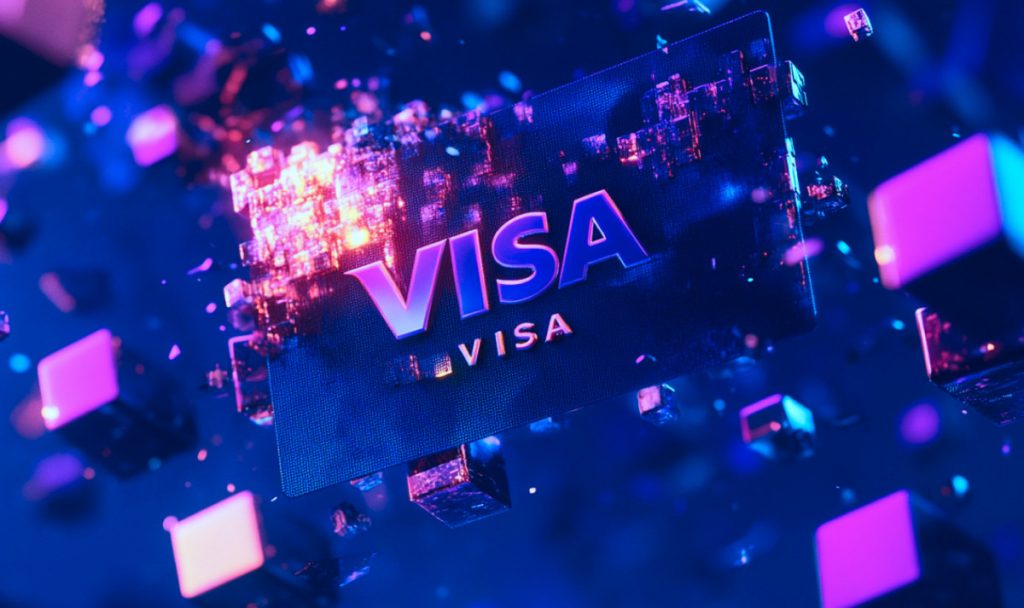Visa and Ethereum Collaborate to Deliver Stablecoins to Banks Around the Globe. Here’s What to Anticipate in 2025.
In Brief
The Visa Tokenized Asset Platform, expected to debut in 2025, is designed to innovate the way banks manage digital assets that are supported by fiat currencies on various blockchain networks, showcasing Visa's commitment to digital payment advancements.

In an exciting development, the Visa Tokenized Asset Platform will be introduced in 2025, aiming to completely reshape how banks issue and manage fiat-backed digital currencies on blockchain networks like stablecoins. For nearly 60 years, Visa has been leading the charge in digital payment innovation, and VTAP reflects the company's ongoing commitment to shaping the future of the financial services sector.
Visa aims to simplify the process for financial institutions to issue and manage digital assets by providing VTAP, a straightforward and secure option. This aligns perfectly with Visa's broader vision of bridging decentralized blockchain networks with traditional fiat systems.
An extensive amount of effort and planning has been invested into the rollout of VTAP, particularly with collaboration from the Spanish banking giant BBVA, which will be among the pioneers to trial the platform in a live setting using the Ethereum blockchain.
Understanding the Importance of Stablecoins and Tokenization in Today's Financial Landscape
In the world of digital assets, stablecoins have emerged as key players, blending the benefits of blockchain technology with the stability of traditional fiat currencies. Unlike their more volatile counterparts like Bitcoin, stablecoins maintain a consistent value, often pegged to currencies like the euro or US dollar. This reliability makes them particularly attractive to banks looking to explore blockchain innovation without jeopardizing their existing operations.
Tokenization, which involves converting physical assets into digital tokens on a blockchain, has gained traction in the finance sector as well. This technology offers a programmable, efficient, and secure approach to digital asset management. Through tokenization, banks can leverage programmable smart contracts to automate transactions while digitizing their assets, streamlining processes such as loans, settlements, and payments.
Visa's VTAP platform leverages both tokenization and stablecoins to facilitate a smooth transition for banks into the digital assets arena. It allows institutions to efficiently manage tokenized deposits, stablecoins, and various forms of digital value.
Tailored Banking Solutions through VTAP
To address the needs of banks that wish to embrace digital banking without disrupting their current operations, Visa developed the VTAP. This platform simplifies the minting, burning, and transfer of stablecoins and other fiat-pegged tokens. Moreover, it integrates seamlessly with a bank’s existing financial infrastructure, enabling the adoption of blockchain technology without necessitating an overhaul of their entire system.
One of the standout features of VTAP is its ability to enable programmability via smart contracts. By digitalizing and automating a variety of functions, such as managing loans and settling payments, it reduces human intervention while boosting operational efficiency.
For example, banks can use smart contracts to facilitate near-instantaneous settlements of tokenized assets or automatically release funds when certain predetermined conditions are met. This programmability will play a vital role in modernizing the financial landscape, which often relies on outdated and sluggish processes.
Beyond enabling seamless integration and programmability, the objective of VTAP VTAP aims to encourage interoperability among different blockchain networks. This means financial institutions can engage with external partners and clients across both private and public blockchains, in addition to their internal systems. Visa envisions a future in which banks utilizing VTAP can effortlessly transfer assets across various blockchain networks, broadening the use cases of tokenized assets in both local and global transactions.
BBVA and Visa Pioneering the Future of Digital Banking
One of the key partnerships in Visa's VTAP initiative is with BBVA, a leading global financial institution based in Spain. BBVA has been at the forefront of the digital asset landscape since 2014, offering services related to Bitcoin trading and custody.
In 2024, BBVA commenced testing the issuance, transfer, and redemption of stablecoins on a test blockchain as part of their efforts with VTAP within a controlled sandbox environment. These initial trials provided BBVA with valuable insights into how blockchain can enhance operational efficiency and allowed them to assess the platform’s viability in real banking scenarios.
Francisco Maroto, BBVA's head of digital assets and blockchain, expressed optimism about the potential of tokenized assets, noting that blockchain has the potential to fundamentally change how value is exchanged digitally and could significantly impact the financial ecosystem overall.
By 2025, BBVA aims to be among the first to conduct a live trial of VTAP on the Ethereum blockchain. The bank plans to issue a stablecoin primarily for internal transactions within its own ecosystem, backed by either the euro or the US dollar. However, as blockchain technology becomes more mainstream, BBVA anticipates a wealth of opportunities to utilize stablecoins beyond its own operations, eventually extending similar offerings to external clients.
The Role of Ethereum in VTAP’s Development
The significance of Ethereum as the foundational blockchain for Visa's VTAP pilot cannot be overstated. For years, Ethereum has been a leader in the smart contract arena, providing a stable and secure environment for developing decentralized applications (dApps) and issuing digital assets. Visa’s decision to utilize Ethereum for this initiative underscores its confidence in the blockchain's ability to handle intricate financial transactions.
Ethereum will serve as the backbone for creating and transferring stablecoins during the 2025 VTAP trial. Given its proven capacity to facilitate decentralized finance (DeFi) transactions, it fits perfectly with Visa’s foray into blockchain-based digital asset management.
Additionally, banks utilizing VTAP will gain access to a broader ecosystem of blockchain participants due to Ethereum’s widespread adoption in both public and private sectors, unlocking new opportunities for collaboration and innovation within the financial space.
Furthermore, Visa has committed to working closely with regulators, fintech companies, and financial institutions to establish industry standards that ensure the safe and compliant growth of tokenized assets. By fostering collaboration among essential stakeholders, Visa aims to create an environment where digital assets can thrive while maintaining the high trust levels required by both consumers and financial institutions.
Disclaimer
In line with the Trust Project guidelines Please be advised that the information contained on this page is intended for informational purposes only and should not be construed as legal, tax, investment, financial, or any other form of advice. It is crucial to only invest what you can afford to lose and seek independent financial counsel if you have any uncertainties. For additional information, kindly refer to the terms and conditions as well as the support pages provided by the relevant issuer or advertiser. MetaversePost is committed to delivering accurate, impartial reporting, but market conditions may shift unexpectedly.







